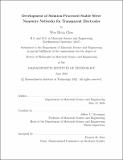Development of Solution-Processed Stable Silver Nanowire Networks for Transparent Electrodes
Author(s)
Chae, Woo Hyun
DownloadThesis PDF (29.89Mb)
Advisor
Grossman, Jeffrey C.
Terms of use
Metadata
Show full item recordAbstract
The continued use of indium tin oxide (ITO) as a transparent electrode for next generation optoelectronic devices will face severe challenges, including the scarcity of raw materials, high cost of processing, and lack of mechanical flexibility. Emerging transparent electrodes composed of solution-synthesized silver nanowire (AgNW) networks are highly appealing alternatives, but their poor stability prevents market adoption. Thus, there is a need to develop scalable and commercially viable processes for fabricating stable AgNW-based transparent electrodes. This thesis seeks to overcome the failure modes of AgNWs by developing fully solution-based fabrication processes for nanocomposite transparent electrodes incorporating AgNWs and Graphene Oxide (GO) or Reduced Graphene Oxide (RGO). In particular, electrophoretic deposition and layer-by-layer deposition were actively explored as processing techniques to achieve AgNW networks protected by thin films of GO or RGO. A first process is developed to fabricate a transferrable AgNW network protected by GO on both sides, leading to exceptional chemical stability. A use case is demonstrated where the transparent electrode is integrated as a back-contact for a semitransparent organic solar cell, leading to a longer device lifetime. A second process is developed towards forming a conformal coating on AgNWs based on nanosized RGO, leading to enhanced all-around stability. A flexible transparent film heater was thus made, demonstrating its exceptional stability under harsh conditions. It is expected that the processing knowledge and structure-property relationships uncovered in this work can be extended to the integration of other emerging low dimensional materials compatible with solution-based processing, and help bridge the gap between proof-of-concept demonstrations and industrial production of functional nanocomposite materials.
Date issued
2022-05Department
Massachusetts Institute of Technology. Department of Materials Science and EngineeringPublisher
Massachusetts Institute of Technology